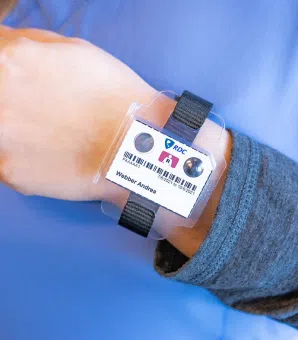
Dosimeter badge services for medical, dental, and veterinary businesses
Learn how Radiation Detection Company’s easy-to-use dosimetry solutions can boost the efficiency of your practice.
You may have heard the acronym TLD, but what exactly does it stand for? And what does it do? In this article we'll deep dive into all things TLDs and their importance in radiation dosimetry.
We hope you find this article informative, and as always, we look forward to hearing your feedback!
A thermoluminescent dosimeter - more commonly called a TLD - is a type of radiation dosimeter. As ionizing radiation passes through the thermoluminescent dosimeter electrons in the material are moved into dosimetric traps and held there until the detector is heated up. Once the temperature reaches a maximum of approximately 400°C, the electrons in these dosimetric traps begin to move. This movement creates a light pulse to be emitted also know n as luminescence. A photomultiplier tube (PMT) is used to count this light emitted and the amount of light emitted is proportional to the amount of ionizing radiation exposure the dosimeter received.
A TLD is considered to be a passive radiation detection device and has become the most commonly used solid-state radiation detector for personnel monitoring.
A thermoluminescent dosimeter is used to measure ionizing radiation, including gamma rays, x-rays, and beta radiation exposures. This small device measures the amount of visible light emitted from a crystal in the detector.
The most common types of thermoluminescent dosimeters are lithium fluoride, lithium borate, calcium sulfate, calcium fluorid, coupled with one or more impurities to produce trap states for energetic electrons.
TLD emit light photons proportional to the irradiation dose when heated. Irradiation, you'll remember, is the process by which an object is exposed to radiation.
Depending on the impurities added to the radiation detector TLD can respond to beta, photons, (gamma and X-rays), and neutron fields.
Radiation dose is the measurement of how much energy is deposited into a material from a radiation source. The dosimeter is capable of measuring the effective dose equivalent at the depth of 0.007 cm Hp(0.07), 0.3 Hp(3), and 1 cm Hp(10) in the body. Hp(0.07) also known as shallow dose equivalent is the dose to the first layer of the live skin and Hp(3) also known as lens dose equivalent.
To learn more about radiation dose, check out our recent blog Dosimetry 101: Everything You Need to Know About Radiation Dosimetry - Radiation Detection Company (radetco.com)

Radiation exposure is broken into two types. Non-ionizing radiation includes radio waves, cell phones, microwaves, infrared radiation, and visible light.
Ionizing radiation includes ultraviolet radiation, radon, x-rays, and gamma rays. TLD cards are used to measure ionizing radiation. Proper handling and storage of TLD elements ensures accurate measures of radiation exposure and occupational dose.
The thermoluminescent dosimeter was invented in 1954 by Professor Farrington Daniels at the University of Wisconsin-Madison.
Since 1969, the International Atomic Energy Agency's dosimetry program has operated a service to validate the calibration of radiation beams. The IAEA mainly focuses on cooperation in the nuclear field and seeks to promote the safe, secure, and peaceful use of nuclear technologies in the world.
TLDs are a very popular area of study. The energy response of TLDs is one facet that is often tested - specifically the difference between standard TLDs and high-sensitivity TLDs - to observe how radiation interacts.
Radiation Detection Company offers a wide range of affordable and comprehensive radiation protection solutions to accommodate the needs of any organization, big or small. Our personal dosimeters offer a variety of service types detailed below.
If you need help understanding what dosimeters your organization needs, please contact our world-class customer service team, and they will be happy to provide guidance.
Our TLD-XBGN is a four-element radiation TLD badge with a minimal reportable dose of 10 mrem (0.10 mSv) and a lower limit of detection of 1 mrem (0.01 mSv). These dosimeter badges are used to monitor exposure to a single occupational worker who is potentially interacting with radioactive materials.
Our XTLD-XBG extremity is a single element ring dosimeter for extremities. The ring badge is optimal for radiation workers whose job functions potentially require their arms or legs to receive a higher exposure.
Our TLD-XBGN is a four-element radiation TLD badge with a minimal reportable dose of 10 mrem (0.10 mSv) and a lower limit of detection of 1 mrem (0.01 mSv). The badge is fitted with a Velcro strap to be worn around the wrist. The wrist badge is ideal for radiation workers whose arms may receive a higher potential exposure.

Our TLD-XBGN fetal monitor is a four-element radiation TLD badge with a minimal reportable dose of 10 mrem (0.10 mSv) and a lower limit of detection of 1 mrem (0.01 mSv).
Fetal Monitors are available for radiation workers who are pregnant to ensure that the fetus does not exceed a significant radiation dose of 500 mrem for the entire gestational period or 50 mrem per month. The badge should be worn on the abdomen to provide the best estimate of the dose to the embryo/fetus.
Area TLD cards can be used to ensure that the public is not being exposed to more than 100 mrem/year from outside a room/building. In addition, they can monitor radiation doses for employees who are potentially occupationally exposed.
These TLD cards can be placed in a room where the radiation source is located, or a room near a source that radiation could potentially reach.
Want to learn more about RDC’s TLD badge solutions? Please visit our Solutions page to view our full suite of offerings.
Have a question that we did not address in this article? Please reach out to our Customer Care team, and one of our specialists will be happy to assist you.
Learn how Radiation Detection Company’s easy-to-use dosimetry solutions can boost the efficiency of your practice.
